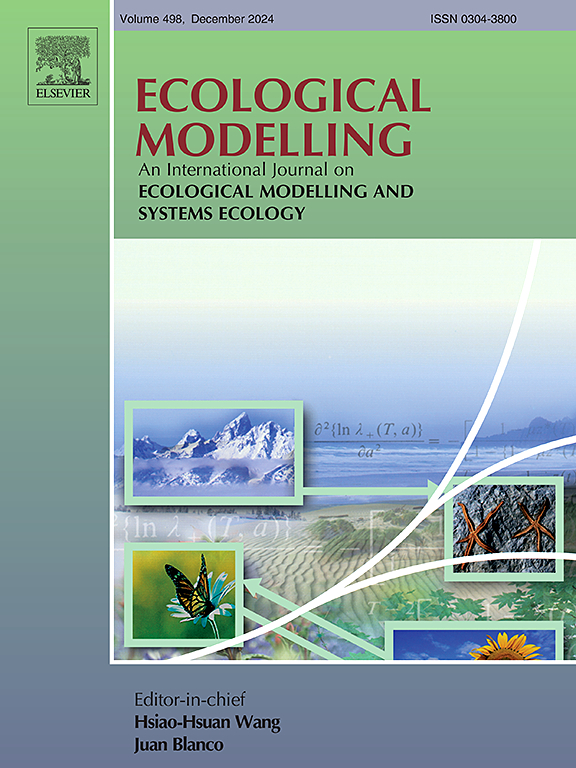Enhancing ecological sustainability in ion-adsorption rare earth mining areas: A multi-scale model for assessing spatiotemporal dynamics and ecological resilience
IF 2.6
3区 环境科学与生态学
Q2 ECOLOGY
引用次数: 0
Abstract
With the increasing global demand for Rare Earth (RE) resources, ionic RE deposits, characterized by a high concentration of medium and heavy RE elements, have become critical to strategic resource planning. These deposits are primarily located in southern China's hilly and mountainous regions, where RE elements are adsorbed onto clay minerals in an ionic state. The deposits are small, scattered, and predominantly mined through solution leaching, a method effective for resource extraction but with severe ecological repercussions, including soil, vegetation, and water degradation. Currently, quantitative assessment methods for evaluating the Ecological carrying capacity (ECC) of ionic RE mining areas on a regional scale remain limited. To address this gap, this paper presents an ECC evaluation model based on the Driver-Pressure-State-Impact-Response (DPSIR) framework, tailored specifically for ionic RE mining areas. Twenty-two ecological indicators were selected to capture the unique environmental conditions of these sites, forming a comprehensive ECC evaluation model applicable to ion-adsorbed RE mining areas. Using Lingbei in Dingnan County, China, as a case study, we conducted a long-term dynamic analysis of the mining area's ECC and employed geospatial analysis to identify the key drivers and their multidimensional interactions across various periods, examining the evolution patterns of critical ecological factors. The results reveal that: (1) from 2000 to 2020, the ECC of the Lingbei RE mining area exhibited a general trend of initial decline followed by improvement. From 2000 to 2010, ECC consistently declined, with moderate ECC zones shifting to poor categories. Since 2010, however, ECC has gradually improved, with the poor ECC zones recovering to moderate levels by 2020. (2) Throughout 2000–2020, vegetation cover (S1) was consistently the primary driver of ECC in the mining area. Early-stage ecological degradation was driven primarily by vegetation loss and desertification (P3), with additional impacts from climatic factors such as surface heat (D3) and precipitation (D5). After 2010, vegetation recovery contributed to improved ECC, while pressures from desertification and climate stress eased. Contributions from biodiversity (S4) and soil organic matter (S3) also increased, and interactions between any two factors had a significantly greater effect on ECC than single factors alone. This study highlights the critical role of vegetation recovery and environmental interactions in improving the ECC of ionic RE mining areas. The findings provide insights into key drivers and pressures, offering guidance for mitigating environmental degradation and promoting sustainable development in RE mining regions.
增强离子吸附型稀土矿区生态可持续性:时空动态与生态恢复力的多尺度模型
随着全球对稀土资源需求的不断增长,以中重稀土元素含量高为特点的离子型稀土矿床已成为战略资源规划的重要组成部分。这些矿床主要位于中国南方丘陵和山区,稀土元素以离子态吸附在粘土矿物上。矿床小而分散,主要通过溶液浸出开采,这是一种有效的资源提取方法,但具有严重的生态影响,包括土壤、植被和水的退化。目前,在区域尺度上评价离子稀土矿区生态承载力(ECC)的定量评价方法有限。为了解决这一差距,本文提出了一个基于驱动-压力-状态-影响-响应(DPSIR)框架的ECC评估模型,专门为离子稀土矿区量身定制。选取22个生态指标,捕捉这些场地独特的环境条件,形成适用于离子吸附稀土矿区的综合ECC评价模型。以定南县灵北为例,对矿区生态环境影响因素进行了长期动态分析,并运用地理空间分析方法,确定了矿区生态环境影响因素的关键驱动因素及其在不同时期的多维交互作用,考察了关键生态因素的演变规律。结果表明:(1)2000 ~ 2020年陵北稀土矿区生态环境承载力总体呈现先下降后提高的趋势;从2000年到2010年,生态环境质量持续下降,生态环境质量中等的区域向生态环境质量较差的区域转移。然而,自2010年以来,ECC逐渐改善,到2020年,ECC较差的地区恢复到中等水平。(2) 2000-2020年,植被覆盖(S1)始终是矿区生态承载力的主要驱动因素。早期生态退化主要受植被丧失和荒漠化(P3)驱动,地表热量(D3)和降水(D5)等气候因素也有影响。2010年以后,植被恢复对生态环境质量的改善有所贡献,荒漠化和气候压力有所缓解。生物多样性(S4)和土壤有机质(S3)对生态承载力的贡献也有所增加,且两者交互作用对生态承载力的影响显著大于单一因素。本研究强调了植被恢复和环境相互作用在改善离子稀土矿区生态环境保护中的关键作用。研究结果揭示了稀土矿区的主要驱动因素和压力,为缓解环境退化和促进可持续发展提供了指导。
本文章由计算机程序翻译,如有差异,请以英文原文为准。
求助全文
约1分钟内获得全文
求助全文
来源期刊

Ecological Modelling
环境科学-生态学
CiteScore
5.60
自引率
6.50%
发文量
259
审稿时长
69 days
期刊介绍:
The journal is concerned with the use of mathematical models and systems analysis for the description of ecological processes and for the sustainable management of resources. Human activity and well-being are dependent on and integrated with the functioning of ecosystems and the services they provide. We aim to understand these basic ecosystem functions using mathematical and conceptual modelling, systems analysis, thermodynamics, computer simulations, and ecological theory. This leads to a preference for process-based models embedded in theory with explicit causative agents as opposed to strictly statistical or correlative descriptions. These modelling methods can be applied to a wide spectrum of issues ranging from basic ecology to human ecology to socio-ecological systems. The journal welcomes research articles, short communications, review articles, letters to the editor, book reviews, and other communications. The journal also supports the activities of the [International Society of Ecological Modelling (ISEM)](http://www.isemna.org/).
 求助内容:
求助内容: 应助结果提醒方式:
应助结果提醒方式:


